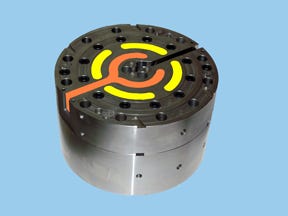Pipe extrusion: Polish processor changes heads, boosts output
As it transitions to processing of lead-free PVC compounds, plastic pipe processor Skoplast (Odolanow Kaczory, Poland) also changed its extrusion heads, with new 3LRK pipe heads replacing the feed block technology in use since 2000. The result? Material savings and reduced energy use combine for more pipe at equal cost.
December 3, 2009
As it transitions to processing of lead-free PVC compounds, plastic pipe processor Skoplast (Odolanow Kaczory, Poland) also changed its extrusion heads, with new 3LRK pipe heads replacing the feed block technology in use since 2000. The result? Material savings and reduced energy use combine for more pipe at equal cost.
The 3LRK pipe tooling, also known as Lichter pipe heads after the developer, Heinz Lichter of Heinz Lichter Extrusionstechnik (Steinfurt, Germany), are available in three standard sizes covering pipes with inner diameter ranging between 50-400 mm. For diameters above 400 mm, the largest of the three can be fitted with an extension module. The 3LRK is suitable for extrusion of smooth multilayer pipes in PVC, PVC-U, PE, and PP.
|
Krzysztof Szkopek, one of the owners of Skoplast, says the new pipe heads pay for themselves in about six months as they make old lines more efficient, and improve the quality on both old and new lines.
The Lichter pipe heads are based on a spike die. For PVC and PVC-U this means the melt flow is delivered by the extruder into a circular shaped flow channel. For the core layer, it is transformed by the mandrel directly into a coaxial spine flow. The melt of the outer layer passes through formed channels into a relief zone that is said to reduce material deformation; the melt flows eventually to the exit nozzle.
As an example of potential material savings, Lichter asks processors to consider extrusion of a class SN4 pipe with three layers and 160-mm diameter, with the extruders’ output 450 kg/hr. With a total density of 1.16 g/cm3, output of 4476 m/day is achieved with conventional feed blocks. The 3LRK-pipehead allows for a total density of 0.83 g/cm3, he claims, due to its construction and ability to use more foam in the center layer. As a result, the output capacity with the same material input increases to 6234 m/day, an increase of 39%. The increase stems from more consistent outer layers (because of improved melting diffusion) and a less dense inner layer because of the optimal form of the flow channels, the recipe, and the process technology applied.
Regarding maintenance, Krzysztof Szkopek says the 3LRK pipe heads have been run with stops only every four-six months for cleaning of their flow channels. Restarting production also is faster, he says. Lichter also has developed a pipe measurement system whereby the layer thickness and surface volume of the separate layers over the total circumference of the pipe are measured. Using these measurements, changes can be made to the recipe and extrusion line to help optimize line efficiency. —[email protected]
About the Author(s)
You May Also Like



